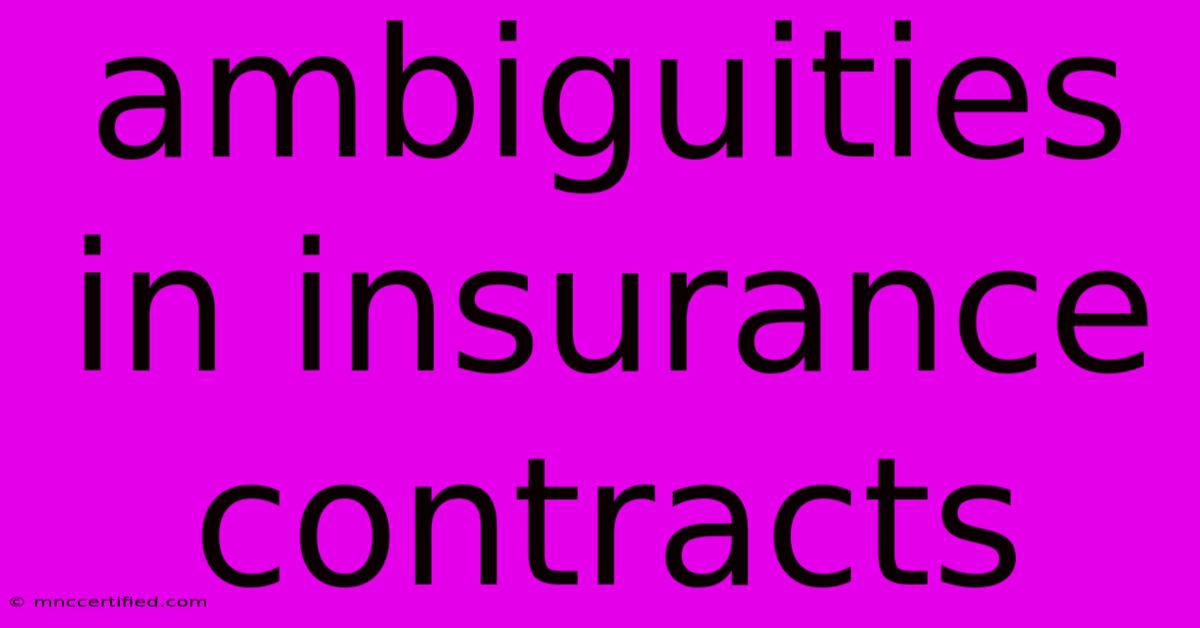Ambiguities In Insurance Contracts

Table of Contents
Ambiguities in Insurance Contracts: A Guide for Policyholders and Insurers
Insurance contracts, while designed to protect, often contain complex language leading to ambiguities. These ambiguities can create significant disputes between insurers and policyholders when it comes to claims. Understanding how courts interpret these ambiguities is crucial for both parties. This article explores common sources of ambiguity and strategies for mitigating risks.
What Constitutes an Ambiguity in an Insurance Contract?
An ambiguity arises when a clause or provision in an insurance policy is susceptible to more than one reasonable interpretation. This doesn't mean any slight uncertainty; the ambiguity must be material, meaning it affects the outcome of a claim. Courts typically look for situations where the language is:
- Unclear: The wording is vague, imprecise, or lacks specific definition. For instance, a policy might use the term "accident" without clarifying its meaning in the context of the coverage.
- Contradictory: Different parts of the policy contradict each other, leaving conflicting interpretations. This is often seen in exclusions that seem to clash with the main coverage promises.
- Missing Information: Essential details are omitted, creating room for differing interpretations. A policy might lack a clear definition of a covered peril or the process for filing a claim.
Example: A policy covering "accidental damage" to a vehicle might be ambiguous if it doesn't define "accidental." Did the damage occur due to a sudden, unforeseen event, or does it encompass gradual wear and tear? This lack of clarity can lead to disputes.
How Courts Interpret Ambiguous Insurance Policies
Most jurisdictions follow the principle of contra proferentem, meaning that ambiguous language in a contract is interpreted against the party that drafted it – the insurance company. This is based on the assumption that the insurer, having more expertise, could have written a clearer policy. However, this rule doesn't apply if the meaning is clear despite the potentially clumsy wording.
Courts also consider:
- The reasonable expectations of the insured: Did the average policyholder understand the policy's coverage based on the language used? If the language leads a reasonable person to a different conclusion than the insurer's interpretation, the court may favor the policyholder.
- The entire policy context: The court examines the entire policy, not just the ambiguous clause in isolation, to understand its overall meaning and intent.
- Industry standards and practices: Courts might consider standard practices within the insurance industry when interpreting ambiguous terms.
Common Sources of Ambiguity in Insurance Policies
Several common areas frequently lead to ambiguities:
1. Definitions of Key Terms:
- Accident: As mentioned above, the definition of "accident" varies widely.
- Occurrence: Similar to "accident," "occurrence" can encompass a broad range of events, leading to disputes.
- Coverage Exclusions: Exclusions are often poorly defined or broadly worded, leaving room for debate on whether a specific situation is excluded from coverage.
2. Causation Clauses:
Policies often contain clauses specifying the cause of loss. Ambiguity can arise in determining whether a particular event was the "proximate cause" of the loss. This is particularly relevant in property and casualty insurance.
3. Policy Limits and Deductibles:
Ambiguity can surround how policy limits and deductibles apply in complex situations, especially with multiple claims or covered perils.
Mitigating Ambiguities: Steps for Policyholders and Insurers
Both policyholders and insurers can take steps to reduce the risk of ambiguities:
For Policyholders:
- Read your policy carefully: Don't just skim; take time to understand the terms, conditions, and exclusions.
- Ask questions: If anything is unclear, contact your insurer for clarification before you need to file a claim.
- Keep detailed records: Maintain thorough records of your policy, payments, and any communication with your insurer.
- Seek professional advice: Consult with an insurance professional or attorney if you encounter ambiguous language or have a dispute with your insurer.
For Insurers:
- Use clear and concise language: Avoid jargon and ambiguous terms.
- Define key terms explicitly: Provide clear definitions for all critical terms.
- Review and update policies regularly: Keep policies current and consistent with industry best practices and legal requirements.
- Provide clear claims procedures: Ensure the claims process is straightforward and easy to understand.
Conclusion: Clarity is Key
Ambiguities in insurance contracts can have significant consequences for both insurers and policyholders. By understanding the common sources of ambiguity and taking proactive steps to mitigate risks, both parties can contribute to a fairer and more efficient insurance process. Prioritizing clear and unambiguous language in insurance policies is crucial for protecting the interests of all parties involved. The goal should always be to ensure that the policy's coverage is transparent and easily understood.

Thank you for visiting our website wich cover about Ambiguities In Insurance Contracts. We hope the information provided has been useful to you. Feel free to contact us if you have any questions or need further assistance. See you next time and dont miss to bookmark.
Featured Posts
-
Friday Football Accumulator 18 1 Nations League Punt
Nov 16, 2024
-
Ronaldo Playing Today Portugal Poland 2024
Nov 16, 2024
-
Billy Bob Thornton On Robert Redford
Nov 16, 2024
-
Estrella Insurance Fort Lauderdale
Nov 16, 2024
-
Stallone Trump A Second Washington
Nov 16, 2024